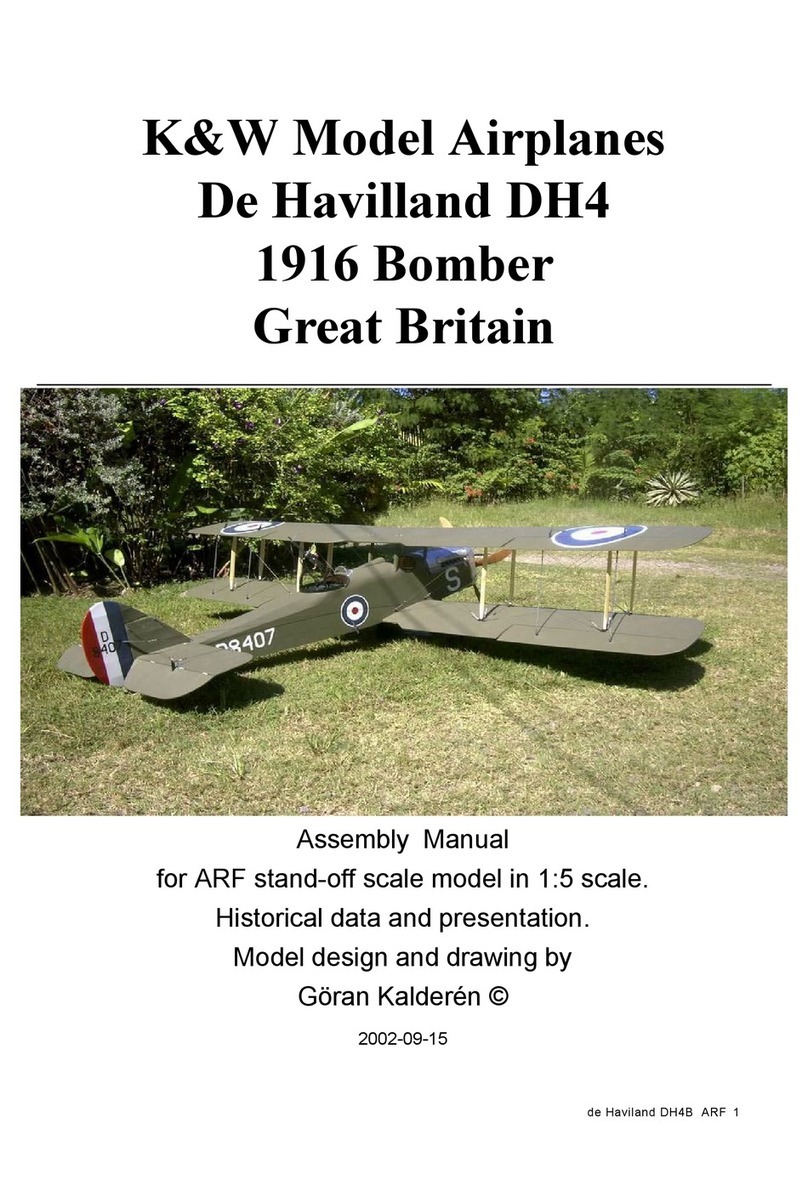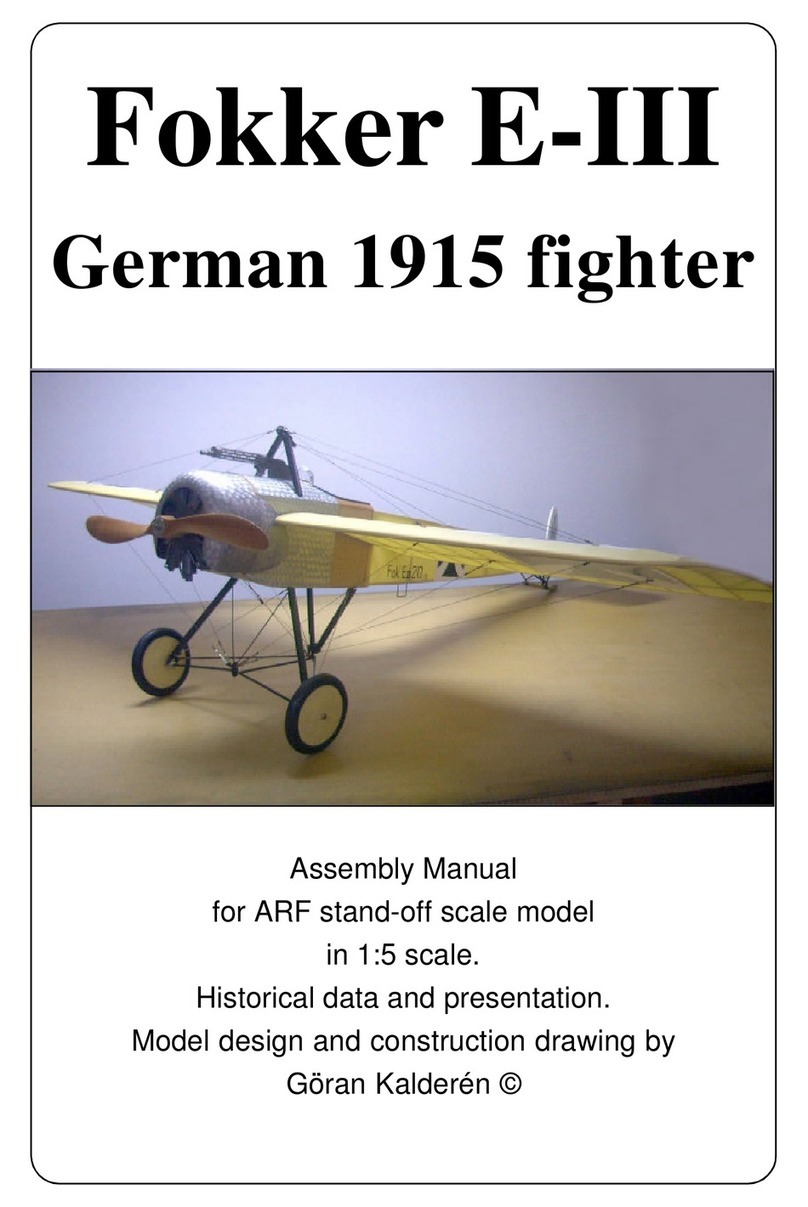
Theaircraftwasarmedwithasinglesyn-
chronized .303 Vickers machine gun with 963
rounds of ammunition in the nose for the pilot
and a .303 Lewis machine gun for the observer
with seven 97 round ammunition drums. Some
aircraft were upgunned in the field with an addi-
tional Lewis gun mounted over the wing to aug-
menttheforwardfirepowerand twin Lewis guns
in the rear cockpit mounted on a Scarff ring.
TheincreasedproductionrateatBristol’s
for the F2B resulted in a shortage of engines
sinceRolls-Roycewasunableto keep pace with
the demand for Falcon engines As a result, al-
ternative engines were examined and tested;
includingtheSiddeleyPuma,Hispano-Suiza200
hp. Hispano-Suiza 300 hp and the 200 hp Sun-
beam Arab. The Sunbeam Arab being finally
chosen, although others continued to be tested
since the Arab equipped variants proved
to be somewhat under-powered. The installa-
tionoftheArabenginealteredthenosecontours
andexhaust stackarrangement.
Before the end of the First World War,
the Bristol fighter was to see service in various
theatersofwar,including with No 139inItaly and
No67 (Australian) Squadron in the Middle East
Nos. 33, 36, 39, 76 and 141 Squadrons used
Bristol Fighters for home defense duties.
F2Bsusedbyhomedefenseunits as night fight-
ers were modified in a number of ways. Some
were fitted with navigation lights on the lower
wing tips and rudders, Holt flare brackets be-
neath each lower wing tip and illuminated gun
sights.Othernight fighters werefitted with addi-
tional forward firing machine guns. One aircraft
ofNo39HomeDefenseSquadronhadtwoLewis
gunsfitted over thewing in addition to itsnormal
single Vickers gun and twin Lewis guns for the
observer.
ByNovember of1918 over5,500 Bristol
fighters,mainly F2Bs, had been orderedand, of
these, 3,101 had been taken into the RFC and
RAF. Although the Armistice led to cancellation
of some orders, the “Biff” as it was known to
wartime airmen, continued to be manufactured
until September of 1919, with a total of 4,747
beingproduced.
Documentation is available in Bristol Fighter
inAction,Aircraft#137bySquadron/signalPub-
lications Inc., 1115 Crowley Drive, Carrolltown,
Texas75011-5010,USA,ISBN-0-89747-301-9.
Bristol Fighter by JM Bruce, Albatros Produc-
tionsLtd.,10 Long view,Berkhamsted, Herford-
shire,HP41BY,GreatBritain.ISBN-0-948414-85-5.
Bristol Fighter F2B
For the British aircommand it became
in1916 obvious thata replacement forthe slow
andvulnerable BE2 series of aircraft was badly
needed. Bristol at this time had designed a 2
seater airplane of girder box design. To over-
comethe restricted forwardview for thepilot the
upper wing was placed only 1 foot above the
fuselage.The pilot’s line of sightwas obstructed
only by the mere airfoil section thus rendering
goodvisibility forward/upwardandforwarddown-
ward. The necessary distance between wing
planes was obtained by moving the lower wing
downwardunder the fuselage.The first produc-
tion aircraft were designated F2A but when put
in service as a reconnaissance aircraft, the old
tactics were used and the plane became easy
preyfortheopponents.
A revised model F2B fighter/recon-
naissance with improved 275 hp. Rolls-Royce
Falcon engine and fighter tactics applied, be-
cameatremendous success. Thisengine is liq-
uidcooledandtheradiatorfirst deployed as side
mounted, soon was changed and located up
front giving the nose a characteristic outline.
Thearmament was a Vickers .303machine gun
mountedunder the hoodand shooting synchro-
nized to fire through the propeller arc through a
roundoutlet in theupper part of the radiator.For
the observer there was a Lewis machine gun
mounted on a Scarff ring mount.
As production increased during 1917 it
became difficult for Roll-Royce to keep up with
demandandotherengine alternatives were tried
andemployed.
That this was a very successful aircraft
type shows in that more than 4700 aircraft were
producedandthatthatproductioncontinuedlong
afterthewar had ended. Theaircraftsaw action
in many foreign countries and was used by the
British in their overseas operations.
As production of the F2B increased in
speed during the mid-Summer of 1917, addi-
tional Royal Flying Corps squadrons were
formed or re-equipped with the new Bristol
fighter. The production F2B featured a reduced
chordtailplanewithlongerspanelevators.These
were later changed to use the elevators of the
F2Awiththe tail plane ofthe F2B and thisarran-
gement was retained for all wartime F2Bs.
The F2B benefited from the lessons
learned from the first combat use of the F2A
variants.When introducedin combatthey were
flown in action using single seat fighter tactics,
which immediately proved successful.





























